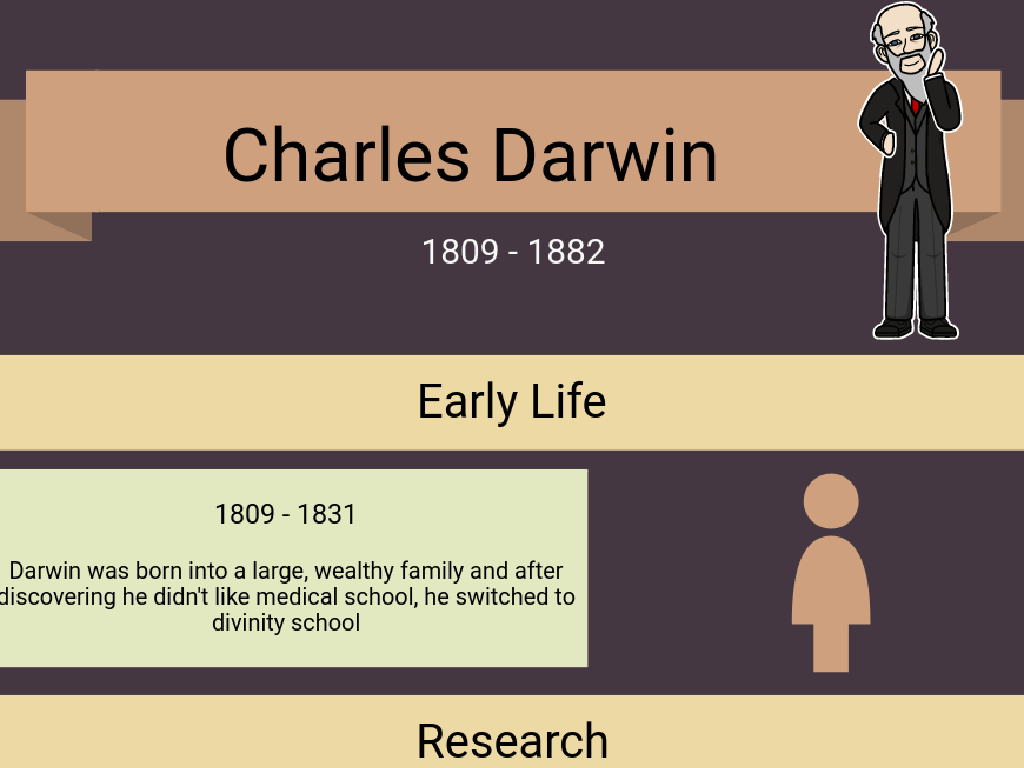Analyze Passages From Travels With Charley: Part 1
Subject: Language arts
Grade: Eighth grade
Topic: Nonfiction Book Study
Please LOG IN to download the presentation. Access is available to registered users only.
View More Content
Exploring ‘Travels with Charley: In Search of America’
– Introduction to Steinbeck’s journey
– Steinbeck’s road trip across America with his poodle, Charley.
– Distinguishing facts and opinions
– Facts are verifiable, while opinions are personal beliefs.
– Author’s perspective in nonfiction
– Steinbeck’s views and insights shape his narrative.
– Purposes of writing nonfiction
– To inform, persuade, convey personal experiences, or explore truths.
|
This slide introduces students to John Steinbeck’s ‘Travels with Charley: In Search of America’, setting the stage for a deeper analysis of nonfiction literature. Students will learn to differentiate between factual information and personal opinions presented in the text, and understand how the author’s perspective influences the narrative. Discuss why nonfiction is written, exploring various purposes such as informing, persuading, sharing personal experiences, or uncovering truths. Encourage students to consider these elements as they read, preparing them for a discussion on how Steinbeck’s work fits into the broader category of nonfiction.
Exploring John Steinbeck and His Journey
– John Steinbeck’s life journey
– Born in 1902, Steinbeck won the Nobel Prize in Literature in 1962.
– His impact on American literature
– His works address social issues & the human condition, shaping American cultural consciousness.
– The purpose behind ‘Travels with Charley’
– To rediscover America & its people, leading to an honest portrayal of the society.
– Steinbeck’s unique narrative style
– Combines personal narrative with social commentary, enriching the travelogue genre.
|
John Steinbeck is a seminal figure in American literature, whose works have left an indelible mark on both the literary world and society at large. His journey in ‘Travels with Charley’ was not just a physical trip across the country, but also a quest for understanding the American identity during a time of great change. This slide aims to give students a background on Steinbeck’s life, his contributions to literature, and the motivations for his travels. Encourage students to reflect on how Steinbeck’s observations might still be relevant today and to consider how an author’s experiences can influence their writing style and the themes they explore.
Setting the Scene in ‘Travels with Charley’
– Steinbeck’s journey overview
– Steinbeck travels the US with his poodle, Charley, to explore and document.
– Significance of visited places
– Each location offers unique insights into American culture and Steinbeck’s perspective.
– Setting’s role in the narrative
– The places and environments shape the stories and themes Steinbeck shares.
– Interaction with Charley
– Charley provides companionship and a unique lens through which Steinbeck views his journey.
|
This slide introduces students to the context of John Steinbeck’s ‘Travels with Charley’. It’s important to highlight the purpose of Steinbeck’s journey, which was to rediscover America and provide a snapshot of the country during the 1960s. Discuss the significance of the places he visits and how they contribute to the narrative, offering a diverse perspective of the American landscape and society. Emphasize how the setting is not just a backdrop but an active element that influences the stories Steinbeck tells. Charley, his poodle, is more than a pet; he’s a character that brings warmth to the narrative and serves as a bridge between Steinbeck and the people he encounters. Encourage students to think about how different settings can change the tone of a story and how an author’s companion might affect their viewpoint.
Literary Elements in ‘Travels with Charley’
– Identifying nonfiction elements
– Elements like tone, style, and perspective
– Steinbeck’s engaging techniques
– Use of descriptive language and personal anecdotes
– Examples from ‘Travels with Charley’
– ‘The redwoods, once seen, leave a mark…’
– Analyzing the impact on readers
– How elements affect our understanding of the text
|
This slide aims to explore the literary elements present in nonfiction works, specifically in ‘Trails with Charley’ by John Steinbeck. Students will learn to identify elements such as tone, style, and perspective, which are crucial in nonfiction narratives. Steinbeck’s use of rich, descriptive language and personal anecdotes serves to draw readers into his journey, making the experience more vivid and engaging. By examining specific passages from the book, students will see these techniques in action. Discuss how Steinbeck’s choices impact the reader’s connection to the text and their understanding of the themes. Encourage students to think critically about why Steinbeck might have chosen to write about his travels in this way and what effect it has on their perception of his journey.
Analyzing ‘Travels with Charley: Part 1’
– Read selected passages
– Identify themes and tone
– Themes like exploration, companionship; tone can be humorous, contemplative
– Discuss observations
– Reflect on Steinbeck’s insights into American culture and landscapes
– Analyze character interactions
– How do Steinbeck’s interactions add depth to the narrative?
|
This slide is aimed at guiding students through an analytical reading of ‘Travels with Charley: Part 1’. Students should start by reading carefully chosen excerpts from the book, focusing on understanding the content and Steinbeck’s writing style. They should look for overarching themes such as the spirit of adventure and the nature of companionship between Steinbeck and his dog, Charley. The tone of the book can vary from humorous to reflective, and students should be able to discern this in the passages they read. Discussions should revolve around Steinbeck’s detailed observations of the American setting and the people he encounters, as well as how these observations and interactions with characters contribute to the richness of the narrative. Encourage students to think critically about the text and to share their interpretations of Steinbeck’s experiences and the literary techniques he uses to convey them.
Character Study: Charley in ‘Travels with Charley’
– Explore who Charley is
– Charley, Steinbeck’s poodle, is a key companion on the journey.
– Analyze Charley’s narrative role
– Charley often serves as a social icebreaker.
– Examine Steinbeck-Charley relationship
– Their bond highlights themes of friendship and loyalty.
– Reflect on Charley’s importance
|
In this slide, we delve into the character of Charley, the poodle companion of John Steinbeck in ‘Travels with Charley’. Charley is not just a pet but an essential character that influences the narrative and Steinbeck’s interactions. Students should analyze how Charley’s presence affects the story’s progression and Steinbeck’s experiences. Discuss the dynamics of their relationship and how it adds depth to the human experience portrayed in the book. Encourage students to think about why Steinbeck chose to include Charley in his travelogue and what Charley represents in the broader context of the narrative.
Exploring Themes and Motifs in ‘Travels with Charley’
– Identify major themes
– Themes like exploration, companionship, and discovery
– Themes reflecting American culture
– How Steinbeck’s journey mirrors societal values and issues
– Recognize recurring motifs
– Motifs such as the road, Charley, and regional diversity
– Significance of motifs
– Motifs deepen understanding of themes and character motivations
|
This slide aims to delve into the major themes and motifs present in ‘Travels with Charley’ and how they relate to American culture and society. Students should be encouraged to think critically about the themes Steinbeck presents, such as the spirit of exploration and the nature of companionship, and how these reflect the larger American experience. Additionally, identifying motifs like the open road, the presence of Charley as a companion, and the diversity Steinbeck encounters will help students understand the significance of these recurring elements and how they contribute to the narrative and its themes. The discussion should also touch on how motifs support the book’s themes and help in character development. Encourage students to bring examples from the text to support their analysis.
Class Activity: Road Trip Diary
– Imagine your own road trip adventure
– Write a diary entry of your journey
– Describe the setting, mood, and your feelings
– Include detailed observations
– Use sensory details: sights, sounds, smells
– Share thoughts and encounters
– Mention people you meet or interesting events
|
This activity encourages students to engage creatively with the concept of travel as explored in ‘Travels with Charley.’ Students should think about where they would like to go on a road trip and write a diary entry as if they are on that journey. Encourage them to include vivid descriptions and sensory details to bring their writing to life. They should reflect on their thoughts and feelings during the imaginary trip, as well as describe any interesting encounters with people or events. For the next class, students can share their diary entries, which will help develop their narrative skills and ability to convey personal experiences through writing.
Discussion and Reflection: Steinbeck’s Travels
– Share your road trip diaries
– Lessons from travel experiences
– Travel teaches adaptability, culture, and history
– Comparing journeys with Steinbeck
– Consider similarities and differences in experiences
– Insights from ‘Travels with Charley’
– Steinbeck’s observations offer a unique perspective on America
|
This slide prompts students to engage in a discussion about their own road trip diaries in relation to Steinbeck’s ‘Travels with Charley.’ Encourage students to think about what travel teaches us about the world and ourselves. Ask them to compare their hypothetical journeys with Steinbeck’s real one, considering factors like purpose, experience, and personal growth. Steinbeck’s narrative provides rich material for understanding the diversity of American culture and landscape. This discussion will help students to reflect on their learning and to appreciate the value of travel as a means of education.
Homework: Dive into Steinbeck’s Journey
– Read the next chapter of ‘Travels with Charley’
– Summarize the chapter and reflect
– Include main events, themes, and your thoughts
– Analyze Steinbeck’s unfolding journey
– Consider Steinbeck’s experiences, choices, and observations
– Get ready for a class discussion
|
This homework assignment is designed to deepen students’ engagement with ‘Travels with Charley’ by John Steinbeck. Students are expected to read the next chapter, focusing on Steinbeck’s narrative and thematic development. They should write a summary that captures the essence of the chapter, including key events and themes. Additionally, students are encouraged to reflect personally on the reading, connecting with Steinbeck’s insights or critiquing his perspectives. The goal is to prepare students for a thoughtful discussion in the next class, where they will explore how Steinbeck’s journey evolves and how it relates to broader concepts in literature and life. Encourage students to think critically and share diverse viewpoints during the discussion.






